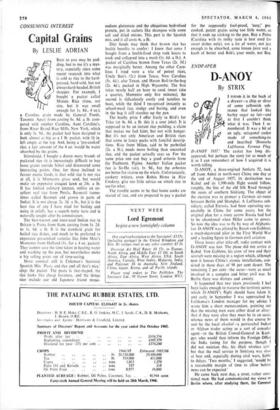CONSUMING INTEREST
Capital Grains
By LESLIE ADRIAN
Stimulated, I bought a dozen more brands of packeted rice (it is increasingly difficult to buy loose grains outside Soho) and discovered some interesting points. One, for those inclined to favour exotic foods, is that wild rice Is not rice at all, it is Minnesota grass seed, but would make an expensive croquet lawn at 24s. a lb. It has limited culinary interest, unlike an ex- cellent real rice from Persia, Basmatti (some- times called Basmuti and grown in parts of India). It is not cheap, 2s. 3d. a lb., but it is the best rice of any I have tried for boiling and using in pilaffs, has a superb nutty taste and is naturally sought after by connoisseurs.
The best-known and most-used Indian rice in Britain is Patna from Siam, costing from Is. 2d. to Is. 6d. a lb. ft is the standard grain for boiled rice dishes, and much to be preferred to expensive pre-cooked varieties like John Moir's Momento from Holland (Is. for a 4 oz. packet). They cannot save the time taken in heating water and washing up the pan, but nevertheless make a big selling point out of time-saving.
More comical still is Coleman's Savoroni Spanish Mix. 'Pasta and rice and all that's nice,' sings the packet. The pasta is rice-shaped, the rice looks like cheap Javanese, and the things nice include our old Japanese friend mono-
sodium glutomate and the ubiquitous hydrolised protein, put in sachets like shampoo with some salt and dried onions. This part is the Spanish mix, and it all costs 4s. a lb.
Diet fiends may think that brown rice has health benefits to confer: I know that some I bought from a health-food shop took hours to cook and collapsed into a mush (Is. 6d. a lb.). A packet of Carolina brown from Texas (2s. 3d.) was marginally better. Among the other Caro- linas I tried were a trio of patent rices, Uncle Ben's (2s.) from Texas, New Carolina (5s. 4d.), also Texan, and Haven Boil-in-the-bag (2s. 4d.), packed in High Wycombe. The first takes nearly half an hour to cook (most take a quarter, Moment° only five minutes), the second is ridiculously costly and tasteless to boot, while the third I recognised instantly as school-meal rice, stodgy and boring, and even in the bag it still starches up the pan.
The booby prize I offer freely to Bird's for Trice (at 4s. 8d. a lb. this is a sour joke). It is supposed to be an instant rice pudding, a claim that makes me feel faint, but not with hunger. But it's not only American and British rices that come in fancy packs with fanciful descrip- tions. Riso from Milan, said to be parboiled (2s. a lb.), needs more boiling than uncooked rice, and the packet actually says so. For the same price one can buy a good arborio from the Piedmont. Pigino. Another Italian packet rice is So-Ho (sic), Is. 9d., but the arborios are better for risotto on the whole. Unfortunately, cookery writers, even Robin Howe in Rice Cookery, give too little advice on which rice to use for what.
The trouble seems to be that home cooks are scared of rice, and are prepared to pay a packet
for the supposedly fool-proof, 'easy,' pre- cooked, patent grains using too little water, so that it ends up sticking to the pan. Buy a Patna (Carolina with its milky taste is best used for sweet dishes only), use a lot of water, not just enough to be absorbed, some lemon juice and a knob of butter and Bob's your uncle, not Ben.


































 Previous page
Previous page